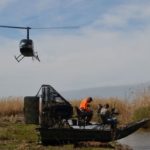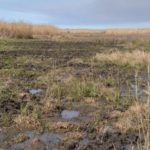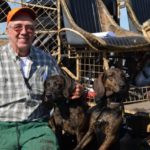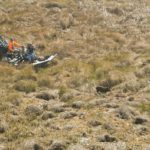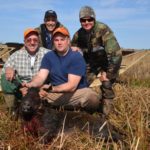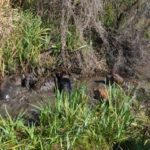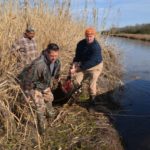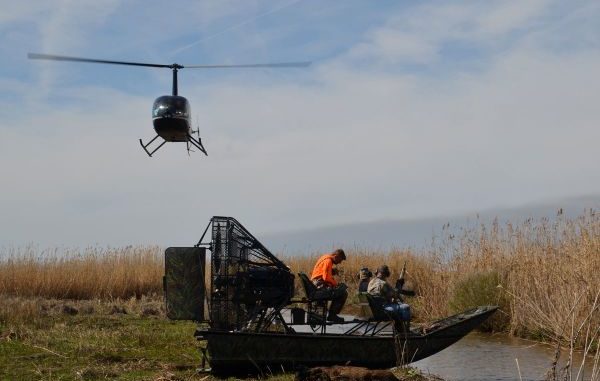
This group of men are on a mission to exterminate the explosion of wild hogs in Louisiana. Here’s how they do it — free of charge.
The hydraulics on the fork lift whined as it picked up the last pallet load of dead hogs.
Fork lift?
Pallet load?
Yeah — that’s what is needed for 2 1/2 tons of dead hogs.
It was hard to believe that just five hours before, I had started on the most-amazing hunt I have ever been on.
My host was long-time friend Danny “Eagle” Edgar, owner of St. Mary Seafood and Marina headquartered in Louisa and Louisiana Bait Products located south of Abbeville.
Looking back, it was hard to tell where the hunt ended and the extermination program began.
The night before the hunt, we talked over huge bowls of pho prepared by Edgar’s fiancée, Tina Le.
“Twenty-five years ago, when we wanted to hunt hogs we hunted more in Texas,” the 64-year-old Edgar said. “About 15 years ago, we began seeing hogs in our marshes and swamps. Then the Louisiana populations started getting out of control immediately after Hurricane Katrina, which seemed to spread them.”
But he said the tropical storm isn’t the only culprit in the animals’ spread.
“Even though hogs are considered a nuisance animal, what supports hog populations are sanctuaries on private property, where people — for whatever reasons — don’t want them hunted,” Edgar said. “I think that hog populations, if not hunted, can get out of hand.”
Between slurps of Le’s delightful Vietnamese soup, Edgar explained that hog hunting has now become a year-round sport.
“We enjoy the meat,” he said. “A lot of the reasons why I like hog hunting is I’m a dog hunter. I grew up hunting deer with dogs.
“We buy and breed our own dogs. A good hog dog is worth a couple thousand dollars. My best dog is a gyp from Illinois — bred to hunt bears — a Plott hound. Plotts in the South are bred to hunt coons. Northern Plotts are bred as game dogs for bear and mountain lion.”
And he’s turned his passion into a business of sorts.
“A group of us has formed Louisiana Wild Hog Removal LLC,” Edgar said. “We kill nuisance hogs on other peoples’ property and donate the meat. We have no problem giving the meat away. You can stop at any filling station and ask anyone if they want a hog. They say ‘What? Are you kidding?’
“I had a stranger on the highway last week who blew his horn and waved me down. I had four hogs in the boat, and he asked me if I had any extra hogs. I told him they were committed, but exchanged phone numbers with him. I’ll give him a couple this week.”
Edgar’s cell phone rang constantly the night before the hunt, as hunters coordinated their plans for the next day’s activities.
He received welcome news: The helicopter had flown the 1,200-acre tract of marsh to be hunted in St. Mary Parish, and the pilot reported the location of abundant hog concentrations — valuable information for planning the hunt.
The next morning was a hive of activity at St. Mary Seafood as men launched boats, loaded dogs and put tracking collars on them.
It was like a dog rainbow: brindled Plotts, blotched Catahoulas, red curs, blackmouth curs and catch dogs of all colors.
Lots of the men sported big sheath knives — pig stickers.
Twenty-two men and two children would participate on the ground: Danny Edgar, Cain Smith, Joey Edgar with his children Kallie and Cole, Ashley “Head” Thompson, Lawrence Thompson, Anthony “Snake” Broussard Sr., Anthony “Junior” Broussard Jr., John Richard, James Aucoin, Ethan Aucoin, Calen Mire, Timmy Dupre, Cody Fortier, David “Tee Coon” Billeaud, Tommy Moyer, Jordan Minor, Dustin Neuville, “Hop” Dugas, Ken LeBlanc, Dustin Landry, Brian Haupt and Brian Fournet.
They would be in seven airboats, one Gator-Tail outboard and a 26-foot outboard-powered Carolina Skiff to carry a big chunk of the thousands of pounds of hogs they would kill.
Hovering over the activity and in constant radio contact with the ground crews would be helicopter pilot André Smith.
It seemed an impossible task to coordinate this large of a crew into an effective unit, but Edgar bounced from person to person and group to group making assignments. To each and every person, he cautioned for the need to keep dogs and boats off property adjacent to the hunt and the need for safety.
It was an impressive sight once the task force set out. The seven noisy airboats, spaced as if in formation along the bayshore looked like nothing so much as the famous helicopter scene in the 1979 classic movie Apocalypse Now.
I half expected Robert Duvall to yell over my shoulder, “You smell that? Do you smell that? Napalm, son. Nothing else in the world smells like that. I love the smell of napalm in the morning.”
On site, everything went off like clockwork. Brian Haupt and Danny Edgar with their crews blocked out one edge of the tract in their airboats. The boats and crews of James Aucoin, Hop Dugas and Shane Boudreaux blocked the other edge.
The airboats of Calen Mire and Cody Fortier shot in the middle, under the eyes of the helicopter.
I rode with Edgar. And things happened quickly.
Haupt and Edgar parked their airboats on opposite sides of a big patch of cane where Fortier had spotted hogs holing up the previous day. Edgar’s Plotts yammered, yelped and strained at their leashes.
He loosed them, and in short order they bayed a hog on the bayou bank.
As soon as that hog was dispatched, another black monster broke into the open from the canes.
A fusillade of shotgun blasts quickly dropped it.
Shortly, an unearthly squealing echoed from the cane patch: A big red cur had a mortal lock on the throat of middling-sized hog.
After breaking the dog’s grip, this swine was quickly killed and bled out with a knife thrust between the throat and shoulder.
The men were still dragging that hog to an airboat when another one stuck its big, ugly black head out of the canes.
It quickly decided that being in the open with all the men and dogs was not a good place to be and ducked back in the canes.
The dogs quickly pushed it out of the canes and into the open. Well ahead of the dogs, it dove into a tangle of knee-high vegetation and hid.
That didn’t last long.
The dogs flushed it and two loads of buckshot cracked its head open.
Shots echoed all around us. The other crews were doing the same thing we were. It seemed like only a blink before we had seven hogs down.
Joey Edgar’s crew in the Carolina Skiff had its hands full keeping up with the hunters. With its 8-foot-wide bow, it looked like a coal barge when it was empty. But now I understood why Danny was fretting the night before about having a boat big enough to carry the day’s kill.
While he hunted, Danny was constantly on his hand-held VHF radio with the other hunters, coordinating activities. He sounded like a broken record with his lectures on shooting safety over the open marsh.
He was also almost paranoid about keeping his hunters and dogs away from the tract’s boundary lines.
“You have to respect neighbors,” he explained. “If you can’t do that, you get a bad reputation.”
The helicopter clattered in from the distance to hover over Edgar’s boat.
“Good! Good,” he muttered. “Now he can find us some more hogs.”
Hogs were everywhere. Some were being openly pursued by dogs. Others were sneakers, trying to slip out of the way of all the commotion.
It was like being on a giant rabbit hunt with 100-pound tusked rabbits.
Although a few men carried pistols for close shots, most used shotguns that were usually loaded with slugs. Fortier equipped the two shooters in his airboat with semi-automatic M-16-style 12-gauge shotguns, but most men used standard hunting shotguns.
Many of the hogs were also sent to hog heaven with the deft use of a large-bladed knife after the dogs brought them down.
The view from the helicopter was even more impressive. Deer were everywhere, but I ignored them and focused on the hunt. The black-bodied hogs stood out well against the brown marsh grasses.
It was fascinating watching the bay dogs work the marsh and close in on hogs trying to hide from them. Airboats cut graceful pirouettes to cut off running hogs or get to a bayed animal.
Smith, the chopper’s pilot explained his role.
“During the hunt, I fly about 100 feet up. I have a rider with me who is on the radio directing the airboats,” Smith said. “When I fly an area a day or two before a hunt to spot hogs, I fly higher — around 400 feet.”
From the air, it’s obvious that this isn’t a free-for-all but rather a carefully planned and conducted massacre.
Back on the ground, things were more pedestrian. Joey Edgar’s big meat wagon was filling up quickly, running from spot to spot picking up hogs piled in twos and threes on the banks of bayous and marked with GPS coordinates.
Well before 1 p.m. it was obvious that his boat wouldn’t carry the whole kill, and hunters began loading hogs in their airboats.
From there, it was back to the St. Mary Seafood dock to unload the pork and divvy it up.
Later that evening, as I was getting my things together back at his home in Lydia, Danny Edgar sank wearily in his recliner and cocked it back.
The telephone rang, and I heard him speak into the receiver,
“Yes, yes, Mr. John. We had a good hunt,” Edgar said. “No one got hurt, and we kept the dogs on the property.
“Oh, yeah: It was a good hunt, alright.”
